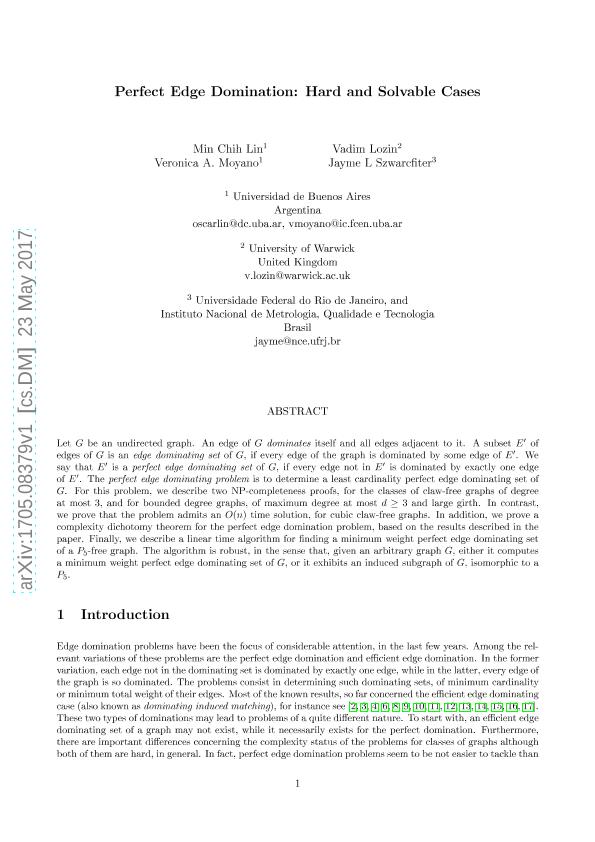Mostrar el registro sencillo del ítem
dc.contributor.author
Lin, Min Chih

dc.contributor.author
Lozin, Vadim
dc.contributor.author
Moyano, Verónica Andrea

dc.contributor.author
Szwarcfiter, Jayme L.

dc.date.available
2018-09-18T19:57:23Z
dc.date.issued
2018-05
dc.identifier.citation
Lin, Min Chih; Lozin, Vadim; Moyano, Verónica Andrea; Szwarcfiter, Jayme L.; Perfect edge domination: hard and solvable cases; Springer; Annals Of Operations Research; 264; 1-2; 5-2018; 287-305
dc.identifier.issn
0254-5330
dc.identifier.uri
http://hdl.handle.net/11336/60143
dc.description.abstract
Let G be an undirected graph. An edge of Gdominates itself and all edges adjacent to it. A subset E′ of edges of G is an edge dominating set of G, if every edge of the graph is dominated by some edge of E′. We say that E′ is a perfect edge dominating set of G, if every edge not in E′ is dominated by exactly one edge of E′. The perfect edge dominating problem is to determine a least cardinality perfect edge dominating set of G. For this problem, we describe two NP-completeness proofs, for the classes of claw-free graphs of degree at most 3, and for bounded degree graphs, of maximum degree at most d≥ 3 and large girth. In contrast, we prove that the problem admits an O(n) time solution, for cubic claw-free graphs. In addition, we prove a complexity dichotomy theorem for the perfect edge domination problem, based on the results described in the paper. Finally, we describe a linear time algorithm for finding a minimum weight perfect edge dominating set of a P5-free graph. The algorithm is robust, in the sense that, given an arbitrary graph G, either it computes a minimum weight perfect edge dominating set of G, or it exhibits an induced subgraph of G, isomorphic to a P5.
dc.format
application/pdf
dc.language.iso
eng
dc.publisher
Springer

dc.rights
info:eu-repo/semantics/openAccess
dc.rights.uri
https://creativecommons.org/licenses/by-nc-sa/2.5/ar/
dc.subject
Claw-Free Graphs
dc.subject
Complexity Dichotomy
dc.subject
Cubic Graphs
dc.subject
Np-Completeness
dc.subject
Perfect Edge Domination
dc.subject.classification
Matemática Pura

dc.subject.classification
Matemáticas

dc.subject.classification
CIENCIAS NATURALES Y EXACTAS

dc.title
Perfect edge domination: hard and solvable cases
dc.type
info:eu-repo/semantics/article
dc.type
info:ar-repo/semantics/artículo
dc.type
info:eu-repo/semantics/publishedVersion
dc.date.updated
2018-09-17T19:31:05Z
dc.identifier.eissn
1572-9338
dc.journal.volume
264
dc.journal.number
1-2
dc.journal.pagination
287-305
dc.journal.pais
Estados Unidos

dc.description.fil
Fil: Lin, Min Chih. Consejo Nacional de Investigaciones Científicas y Técnicas; Argentina. Universidad de Buenos Aires. Facultad de Ciencias Exactas y Naturales. Instituto de Cálculo; Argentina
dc.description.fil
Fil: Lozin, Vadim. University of Warwick; Reino Unido
dc.description.fil
Fil: Moyano, Verónica Andrea. Consejo Nacional de Investigaciones Científicas y Técnicas; Argentina. Universidad de Buenos Aires. Facultad de Ciencias Exactas y Naturales. Instituto de Cálculo; Argentina
dc.description.fil
Fil: Szwarcfiter, Jayme L.. Universidade Federal do Rio de Janeiro; Brasil. Instituto Nacional de Metrologia, Qualidade e Tecnologia; Brasil
dc.journal.title
Annals Of Operations Research

dc.relation.alternativeid
info:eu-repo/semantics/altIdentifier/doi/http://dx.doi.org/10.1007/s10479-017-2664-3
dc.relation.alternativeid
info:eu-repo/semantics/altIdentifier/url/https://link.springer.com/article/10.1007%2Fs10479-017-2664-3
dc.relation.alternativeid
info:eu-repo/semantics/altIdentifier/url/https://arxiv.org/abs/1705.08379
Archivos asociados
